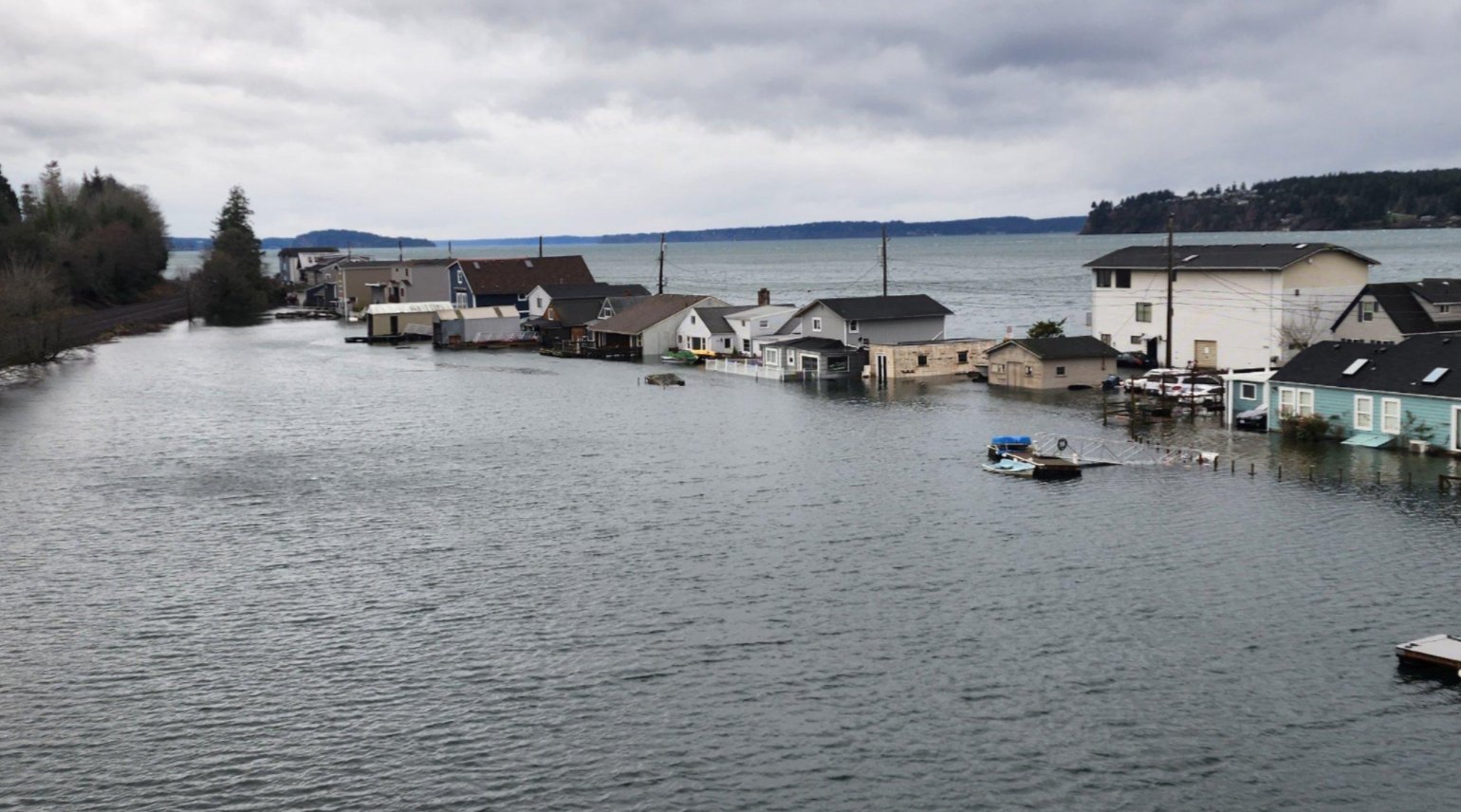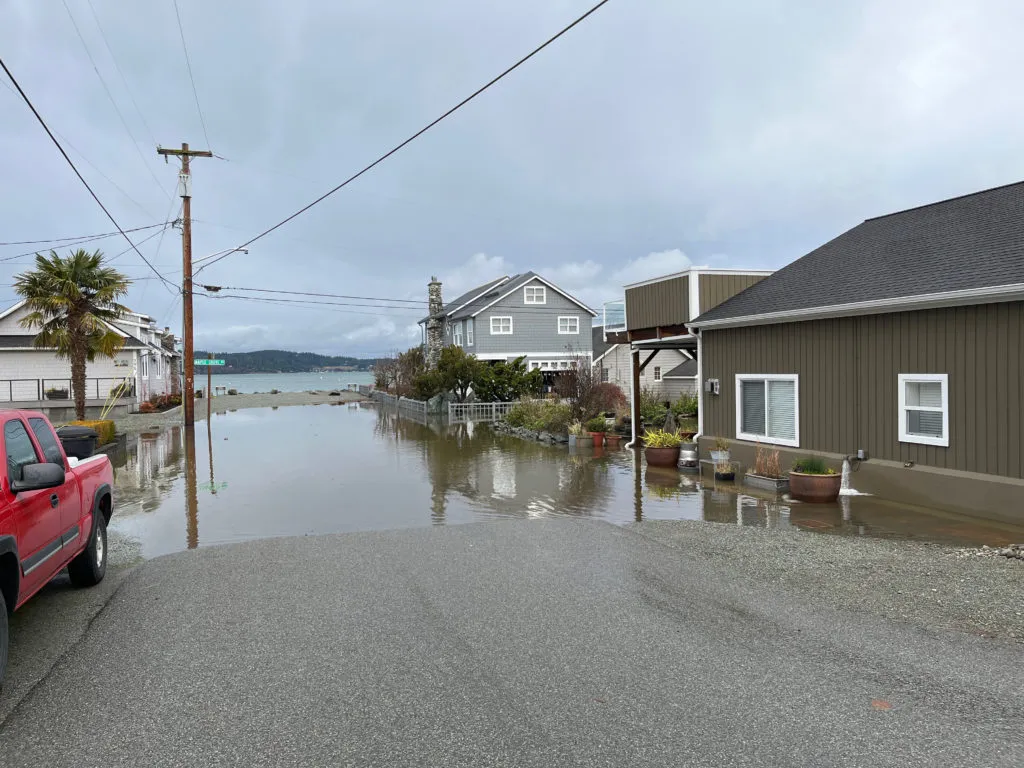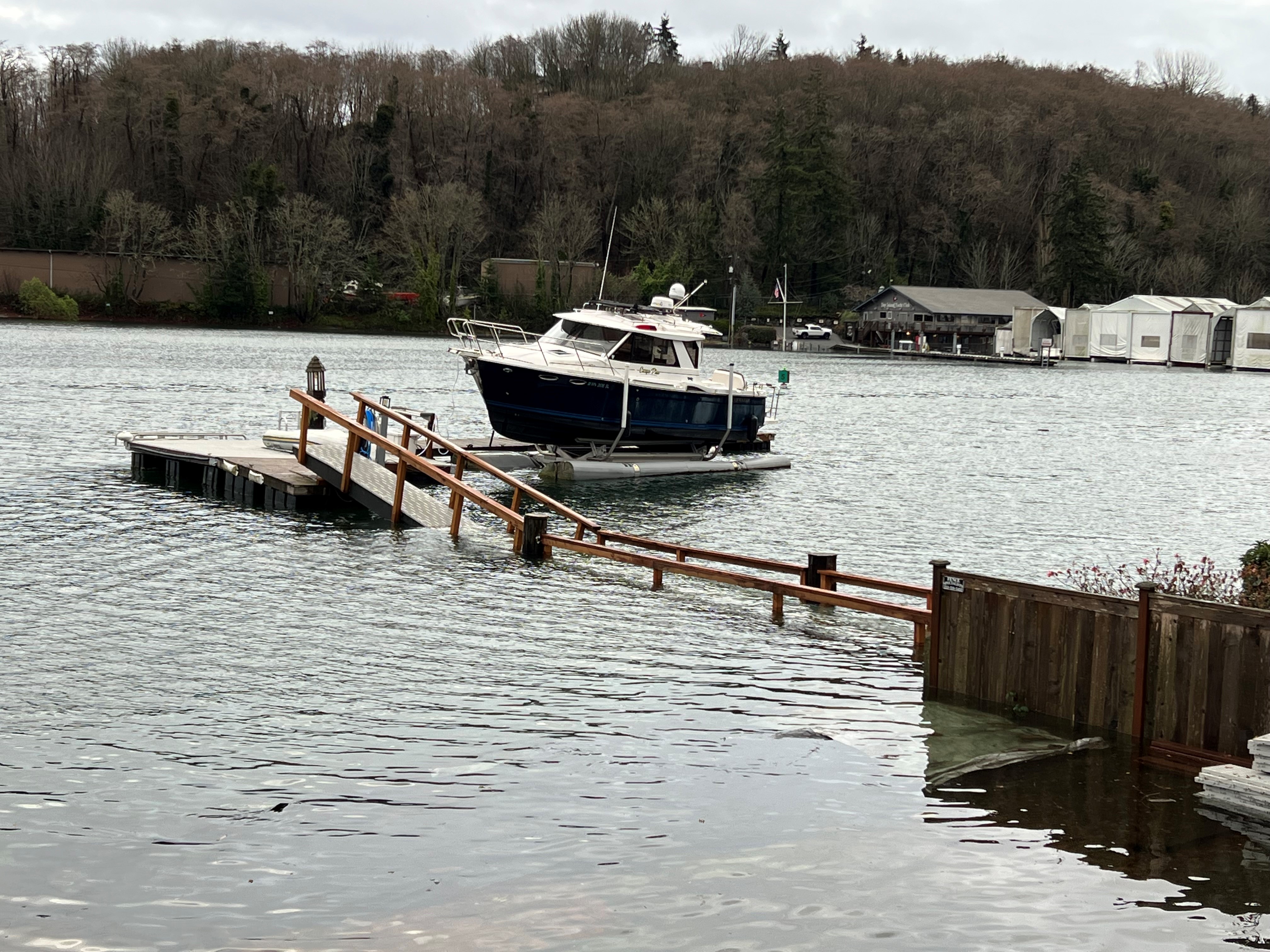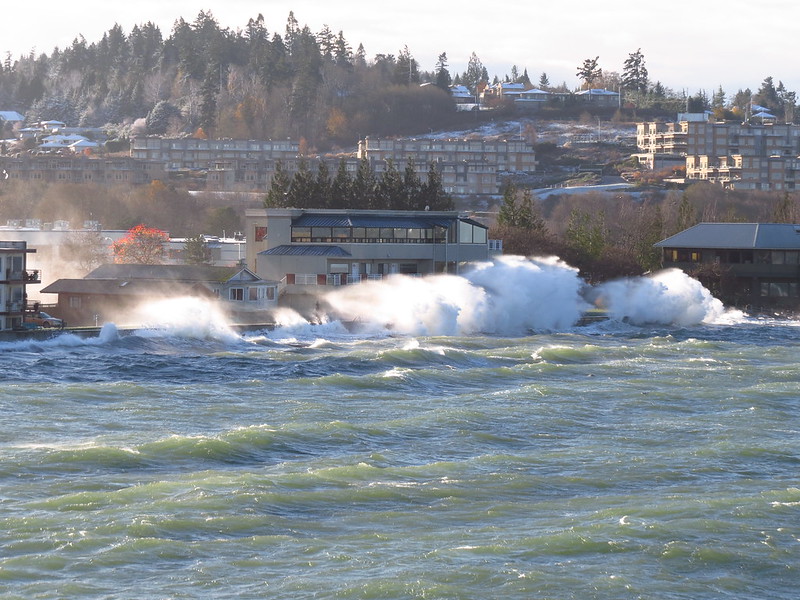
On Dec. 27, 2022, king tides caused coastal flooding on parts of Day Island in Tacoma.
Washington’s 56 cities and counties with marine shorelines are experiencing this winter’s final cycle of king tides.
“King tide” is a colloquial term used to describe an extremely high tide. Ordinary tides are caused by the gravitational pull between the Earth and the moon; king tides happen when astronomical events amplify that pull — most notably when the moon is at its closest point to Earth, and when the sun aligns with the moon and, therefore, exerts its gravitational pull in the same direction.
In December 2022, king tides contributed to coastal flooding after they coincided with a strong, rainy winter storm, low barometric pressure, and prevailing onshore winds.
While the January king tides will be at nearly the same levels as the December king tides, no storms are forecast, and conditions are not predicted to cause the same sort of coastal flooding that occurred last month.
King tides and sea level rise
Paying attention to naturally occurring king tides is important because they provide a glimpse at what local sea level rise will look like in the future. Since we’re still working to curb greenhouse gas emissions, sea level rise is among the more certain climate change impacts.
Over the past century, for instance, sea levels have risen about eight inches in Seattle. The king tides of today will be our everyday high tides in the future.
Causes and impacts
Camano Island flooding from December 2022 king tide.
In Washington, sea level rise is caused by the combined effects of global sea level rise, local factors such as vertical land movement variability stemming from our region’s active tectonics and seasonal ocean elevations due to atmospheric circulation effects.
Sea level rise will increase the severity of existing coastal hazards, such as shoreline and coastal bluff erosion, storm surge, flooding, and saltwater intrusion. These effects will contribute to loss of habitat, damage to homes and key infrastructure, loss of access to shoreline areas, salinity changes in streams and groundwater, threatened food security, and other social, cultural, and economic impacts.
Potential sea level rise scenarios for 171 coastal Washington locations
We work closely with Washington Sea Grant, the University of Washington’s Climate Impacts Group, the Nature Conservancy, and other partners to increase the state’s capacity to prepare for coastal hazards related to sea level rise such as flooding and erosion.
In 2019, we helped finish a three-year effort to improve risk projections, provide better guidance for land-use planners, and strengthen capital investment programs for coastal restoration and infrastructure. These are the types of tools Washington’s coastal communities need to become more resilient to hazards like sea level rise.
As part of the project, UW’s Climate Impacts Group developed data projection tools that provide sea level rise estimates out to the year 2150 for 171 different locations around coastal Washington. Anyone can use the tool to see how sea levels could rise locally. The projections account for the variability in vertical land movement. The projections are also probabilistic because they describe a full range of likelihoods of future sea level changes for a given greenhouse gas scenario over time.
In addition, the National Oceanic and Atmospheric Administration’s Sea Level Rise Viewer can also be used to display community-level simulations of various amounts of coastal flooding or sea level rise.
Future sea level rise threatens homes and structures
According to recent assessments, more than 14,000 homes and structures in Washington — representing a current value of more than $8 billion — may be exposed to coastal flooding by 2050. There are also significant social and biocultural community and tribal assets threatened by coastal flooding, which are much more challenging to quantify.
Although there is scientific uncertainty about the precise amount of sea level rise Washington will experience by the year 2100, the state’s coastal areas are likely to see between 12 and 34 inches of sea level rise relative to contemporary sea levels. Rates could be higher or lower, depending on the local rate of vertical land motion.
Some areas, such as the northwestern part of the Olympic Peninsula, are rising and will experience lower amounts of sea level rise compared to areas that are dropping, like much of Puget Sound. Where we end up within the projected range depends on how successfully we curb global greenhouse gas emissions during the coming decades.
Helping communities along Pacific coast build sea level rise resiliency
From 2019 through 2021, Ecology worked with Washington Sea Grant to carry out the Washington Coast Resilience Action Demonstration Project, which provided hazards assistance to Pacific Coast communities and laid the groundwork for future coastal resilience efforts.
The project was in response to needs voiced by coastal communities and tribes to support their efforts to build local capacity to address coastal hazards, including sea level rise, while strengthening the long-term social, economic, and ecological resilience of the Pacific Coast.
The project helped secure National Fish and Wildlife Foundation funding for a community-driven sea level rise resilience strategy in the Lower Columbia Estuary, as well as Federal Emergency Management Agency funds to help address chronic erosion in Ocean Shores and the North Cove-Tokeland area.
Local Shoreline Master Programs helping address sea level rise
Shoreline Master Programs (SMPs) are local land-use policies and regulations that guide the use of Washington shorelines. Across the state, there are more than 260 cities and counties that have developed SMPs, including 56 jurisdictions with marine shorelines. SMPs apply to both public and private uses for Washington's shorelines. They also protect natural resources for future generations, provide for public access to public waters and shores, and plan for water-dependent uses.
We review and approve SMPs for local governments and provide guidance and technical assistance. However, state law and state rules don’t currently include explicit direction on whether or how to address sea level rise in these programs.
To help our local partners with marine shorelines, we published guidance in 2010 about how to address sea level rise in their local SMPs. We updated this guidance in 2017.
Cities and counties incorporating sea level rise information
In 2021, we found 24 of the 56 jurisdictions with marine shorelines have included sea level rise policies in their Shoreline Master Programs. However, SMPs are only one method jurisdictions use to plan for hazards such as sea level rise. Other planning measures include local comprehensive plans, flood ordinances, hazard mitigation plans, stormwater management plans, and waterfront development plans.
Gig Harbor, for example, elevated its historic net sheds along the city waterfront and is planning for future projects using 2.5 feet of sea level rise above base flood elevation.
King County created a new sea level rise risk area for Vashon-Maury Island. The risk area extends inland from the edge of the existing 100-year floodplain. Under these new regulations, new homes built in the risk area must be built three feet above the 100-year base flood elevation and comply with other floodplain regulations.
City of Olympia during Dec. 27, 2022, king tide
Over the next 40 to 50 years, the city and port of Bellingham will redevelop 237 acres of waterfront property in the downtown area. Planners have raised the sea level planning minimum from 28 to 50 inches.
The City of Olympia worked with its local partners to complete a sea level rise response plan in 2019. The plan identifies needs for protecting the city’s downtown, as well as risks, uncertainties, private and public costs, funding, and a response plan that can be implemented incrementally and modified as new information emerges.
Other coastal jurisdictions are also working on plans and projects to address sea level rise. To view more information about what other communities are doing, visit this GIS website with case studies. Click on the “view the mapper” tab to see different coastal projects. There are 12 different sea level rise case studies.
Competitive pilot grant program
During the 2021-2023 two-year state budget cycle, we launched a $1.2 million pilot program to provide competitive grant funding to local governments to support shoreline planning efforts and Shoreline Master Program implementation. Out of 23 funded projects, seven jurisdictions are addressing sea level rise.
For example, Whatcom County is using grant funding to complete a sea level rise and flood vulnerability assessment. They are working in partnership with the Lummi Nation, local governments, and the U.S. Geological Survey.
Bainbridge Island, Coupeville, Jefferson County, Pacific County, and Westport are using their grants to conduct sea level rise vulnerability assessments and engage the community. The City of Tacoma is working on sea level adaptation guidance for its tideflat areas.
Planning for king tides
A state-led project is encouraging people to upload photos of king tides and other high-water events. The documentation helps scientists, local planners, and others understand how sea level rise and storm surges affect infrastructure and ecosystems. To prepare for king tides and potential flooding, here are a few tips from Washington Sea Grant:
- Be safe! Be extra careful when walking on slippery surfaces and be aware of your surroundings.
- Be aware of weather conditions and big waves.
- Always stay a safe distance away from waves.
- Remember to obey safety signage and guard rails.
- Never turn your back on the ocean.
If you experience urgent but non-life-threatening flooding, we encourage you to contact your local county government.





